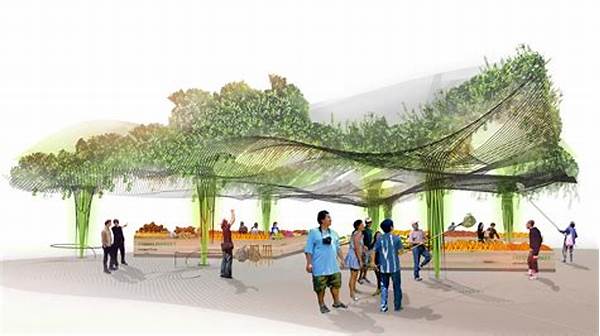Regenerative Design In Architecture

The world of architecture is experiencing a revolution. As sustainable design becomes mainstream, a powerful ally steps into the limelight: regenerative design in architecture. It’s more than just a trend; it’s a movement that intertwines our built environments with the natural world. Imagine buildings that don’t just minimize harm but actively contribute to their ecosystems. From lush green rooftops to high-tech recycled materials, it’s all about creating spaces that give back to the earth, fostering symbiosis between human habitats and the biodiverse planet we call home.
Read Now : Versatile Smart Casual Shoe Options
The Basics of Regenerative Design in Architecture
Regenerative design in architecture is like the cooler, smarter cousin of sustainable design. It’s not just about reducing your carbon footprint—it’s about leaving the planet better than we found it. Think of a building that’s like a living entity, feeding the soil, purifying water, and even creating habitats for critters. This approach ditches the linear, take-make-dispose cycle and embraces a circular one. Innovations like rainwater harvesting systems and living walls become more than just features; they turn buildings into active participants in the environment. So, imagine kicking back in a space that’s not just eco-friendly but also eco-positive, making the future a little less bleak and a lot more green.
Why Regenerative Design in Architecture is Lit
1. Eco Warriors’ Dream: With regenerative design in architecture, buildings can generate renewable energy—talking about solar panels galore!
2. Nature’s Rehab Center: Imagine offices with indoor jungles. Plants suck up toxins and give back mad oxygen.
3. Woke Water Usage: Rainwater harvesting isn’t just cool, it’s necessary! Regen designs love their H2O.
4. Material Magic: Recycled and upcycled materials are the real MVPs in regenerative design in architecture.
5. Biodiversity Boosters: Gimme those green roofs and walls! They’re not just eye candy; they make space for our insect buddies.
Future Vibes of Regenerative Design in Architecture
In the thick of today’s concrete jungle, regenerative design in architecture shines like a beacon of hope. Imagine walking into a city where buildings breathe with life. This isn’t sci-fi; it’s real and it’s glowing with promise. As we face climate change’s gnarly challenges, these smart designs give us a chance to turn things around. Green buildings can clean the air, save energy, and even dish out surplus power to the grid. Regenerative design in architecture takes sustainability to the next level, blending tech with nature for a future where our habitats heal the planet. The growth is wild, and the endgame is a restorative, resilient Earth.
How Regenerative Design in Architecture Flips The Script
1. Green as Life: Not just color, but a way of living.
2. Sustainability’s Swag: It’s cooler, planet-friendlier.
3. From Waste to Wow: Trash finds its purpose.
4. People Power: Designed for today’s eco-conscious crowd.
5. No Planet B: That urgency fuels creativity.
Read Now : Timeless Fashion With Minimalist Pieces
6. Earthy Innovation: Tech meets mother nature.
7. Resilient Revamp: Buildings adapt and thrive.
8. Built to Give Back: Ecosystem collaboration, yo!
9. Future-Forward: It’s here and it’s hip.
10. Healing Habitats: Mischief managed, scores settled.
Game-Changing Examples of Regenerative Design in Architecture
Alright, let’s dish on some banging examples of regenerative design in architecture. First up, we’ve got those epic eco-havens rocking cityscapes. Picture skyscrapers with sustainable skins—they eat pollution for breakfast and generate their own pizzazz with solar bling. Next, there’s that high-tech suburbia where every house flaunts rainwater collectors and plant-covered roofs, turning neighborhoods into breathing gardens. And don’t sleep on urban parks that siphon stormwater and host wildlife right in the middle of the chaos. These places aren’t just spots to chill; they’re alive and kicking, resetting the balance between concrete and green.
Now, think about sites that harness core natural vibes! We’re talking about geothermal heating, man. Imagine staying toasty in winter and cool in summer, all powered by the earth’s crust. It’s like Mother Nature sent an all-year-round heater. It gets even crazier with these cutting-edge constructions that not only gobble up renewable energy but spit it back out into the grid. It’s sharing-is-caring on a planet-wide scale! This regenerative design in architecture goes beyond just fixing stuff. It’s about pimping out the future. These aren’t just buildings; they’re statements, flexing creative muscle and proving that architecture can be resilient, active players in ecological healing. How rad is that?
New Horizons: Regenerative Design in Architecture
Dive into the freshest trends of regenerative design in architecture. It’s all about flipping the script on how buildings play with nature, bringing tech wizardry together with planet love. Imagine eco-savvy constructions that throw shade on waste—all about reduce, reuse, and recycle, baby. Buildings that don zero-carbon pathways and combo with green tech to purify air and water. These aren’t your granddaddy’s designs; they’re tomorrow’s sanctuaries today, cranking out good vibes and future-proofing our hangouts. It’s the ultimate remix of environmental stewardship mixed with comfort and style. Let’s get hyped for a tomorrow where we chill in spaces that vibe with Mother Nature.
Wrap-Up: The Buzz on Regenerative Design in Architecture
All in all, regenerative design in architecture is the future, and it’s not holding back! It’s a rad blend of creativity, determination, and a whole lot of caring for Mother Earth. This is the game-changer we’ve needed. Planting seeds, one building at a time, this design philosophy pushes the boundaries, nurturing resilience in our communities. It calls us to rethink, reimagine, and recreate environments that are lush, vibrant, and downright inspiring. Packed with promise, regenerative architecture’s on the rise, scoring goals for the planet and making space for everyone to flourish. Let’s roll up our sleeves, jump on the eco-train, and ride on into a fresh horizon.